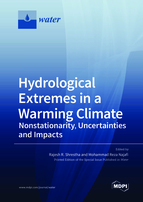Hydrological Extremes in a Warming Climate: Nonstationarity, Uncertainties and Impacts
A special issue of Water (ISSN 2073-4441). This special issue belongs to the section "Hydrology".
Deadline for manuscript submissions: closed (31 January 2022) | Viewed by 40152
Special Issue Editors
Interests: climate change impacts; water resources; watershed hydrology; hydro-climatology; hydrologic modelling; hydrologic extremes; statistical and machine learning methods
Special Issues, Collections and Topics in MDPI journals
Interests: watershed hydrology; hydroclimatic extremes; climate change impact assessment; detection and attribution; infrastructure risk and resilience; regional frequency analysis; multi-modeling and uncertainty assessment; downscaling and bias correction
Special Issues, Collections and Topics in MDPI journals
Special Issue Information
Dear Colleagues,
Climate change induced intensification of the global water cycle is impacting the frequency and severity of hydrologic extremes, including floods and droughts. Future changes in the magnitude, intensity, frequency and seasonality of precipitation, increased evapotranspiration, and shifts from snow towards rainfall regimes can further exacerbate the flood and drought risks in many regions of the world. Furthermore, there are indications that rain-on-snow and atmospheric river driven flood events will intensify in the future climate. These climate induced changes coupled with direct human impacts, such as floodplain development and land use change, could lead to severe natural disasters. Thus, understanding the historical and future trajectories of hydrologic extremes is crucial for water-resources risk assessment and planning. In this context, the nonstationarity of hydrologic extremes is highly relevant, as it could significantly alter the frequency distribution of extreme events. However, the application of nonstationary methods pose a number of challenges, such as selecting an appropriate modelling strategy, handling uncertainties, and understanding and communicating the associated concepts and risks. This special issue will provide a platform for research that will assess the impacts of historical and projected climate change on hydrologic extremes. We seek both application studies and methodological studies that focus on hydrological extremes (peak- and low-flows) and associated risks (floods, droughts). The topics covered by this special Issue will include but not limited to the following:
- Analysis of historical variability and trends in streamflow extremes (e.g., peak flow, low flow, timing) and teleconnections to hydroclimatic drivers
- Model based studies on future changes in hydrologic extremes and the role of internal variability and anthropogenic forcings
- Development and application of nonstationary methods for the evaluation of hydrologic extreme events
- Evaluation of uncertainties of extreme value projections
- Methods to quantify flood and drought risks
- Implications of changes in hydrologic extreme events on water resources management
Dr. Rajesh R. Shrestha
Dr. Mohammad Reza Najafi
Guest Editors
Manuscript Submission Information
Manuscripts should be submitted online at www.mdpi.com by registering and logging in to this website. Once you are registered, click here to go to the submission form. Manuscripts can be submitted until the deadline. All submissions that pass pre-check are peer-reviewed. Accepted papers will be published continuously in the journal (as soon as accepted) and will be listed together on the special issue website. Research articles, review articles as well as short communications are invited. For planned papers, a title and short abstract (about 100 words) can be sent to the Editorial Office for announcement on this website.
Submitted manuscripts should not have been published previously, nor be under consideration for publication elsewhere (except conference proceedings papers). All manuscripts are thoroughly refereed through a single-blind peer-review process. A guide for authors and other relevant information for submission of manuscripts is available on the Instructions for Authors page. Water is an international peer-reviewed open access semimonthly journal published by MDPI.
Please visit the Instructions for Authors page before submitting a manuscript. The Article Processing Charge (APC) for publication in this open access journal is 2600 CHF (Swiss Francs). Submitted papers should be well formatted and use good English. Authors may use MDPI's English editing service prior to publication or during author revisions.
Keywords
- Hydrologic trends
- Peak flow
- Low flow
- Flood
- Drought
- Climate change
- Nonstationarity
- Uncertainty analysis
- Extreme value analysis







